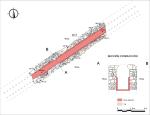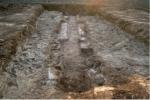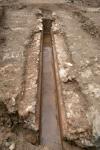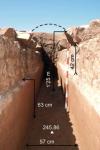Summary (English)
The present archaeological excavation was conducted for the construction of the Mérida-Don Benito-Miajadas Gas pipeline by Gas Extremadura Transportistas SL. Its route in the municipality of Mérida, which extends for 3.35 km, is virtually parallel to that of the Almendralejo-Salamanca ENAGAS gas pipeline.
The construction works involved a mandatory archaeological monitoring, which was appointed to the company Arqueocheck SL. During the trenching process, the Roman Conduit of Cornalvo was transversely ruptured; an incomprehensible event since its layout in the area was well known. In view of this unfortunate episode, the Consorcio of Mérida, making use of its archaeological control functions, has issued the corresponding report and has raised the need to carry out a drilling to document, at least, a small section of the Roman Conduit.
A summary of the interpretation of the archaeological remains documented in this excavation would be as follows: new section close to 10 m in length of the canal that belonged to the hydraulic Roman Conduit from Cornalvo to Augusta Emerita. The visible context at the time of the excavation was a big 65 cm wide by 160 cm deep trench dug out by a tunneling machine to place the gas pipes. The rupture of the Roman canal is clearly visible in the trench section. Its archaeological preservation level was 70 cm below surface level. Covering the Roman canal, with no vaulted cover, there was a thick layer of clay soil.
Once the mechanical lowering took place, the geological bedrock was cleaned by hand, exposing the preserved remains of the canal and the soil that filled it. This whole section was underground, and its width ranged between 1.50 and 1.60 m and its depth was of 1.65 m. There barely were any materials, except for 5 ceramic fragments of uncertain chronology and some animal bones. The specus goes underground for its entirety and was constructed by “lining” the rock by building two opus incertum walls with small and medium-sized stones from the pit itself, which was reused as a quarry. There are no records of the vault that covered it in the excavated section, although its starting point has been documented at some point. Based on the evidence, it is estimated that the total height of the underground channeling was of 1.30-1.40 m. The first of the sections had walls covered with opus signinum, which was probably used to strengthen and seal the area that receives the most pressure from the circulating water.
Thanks to the data extracted from this archaeological excavation, we can conclude that this new documented section of the aquae ductus of Cornalvo follows the Vitruvian principles, which rule that for every 100 feet traveled there must be a slope of half a foot high.
(translation by Himar González González)
- Félix Palma García
Director
- Félix Palma García
Team
- Félix Aparicio
- Francisco Javier Pacheco
- Peones especializados: Manolo Arias, Julián Benítez y Francisco Vigara
Research Body
- Consorcio Ciudad Monumental de Mérida
Funding Body
- Gas Extremadura Transportistas S.L.





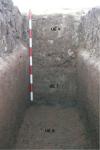
![Download [PDF]](/excavation/skins/fasti/images/results/download_sml.png)
